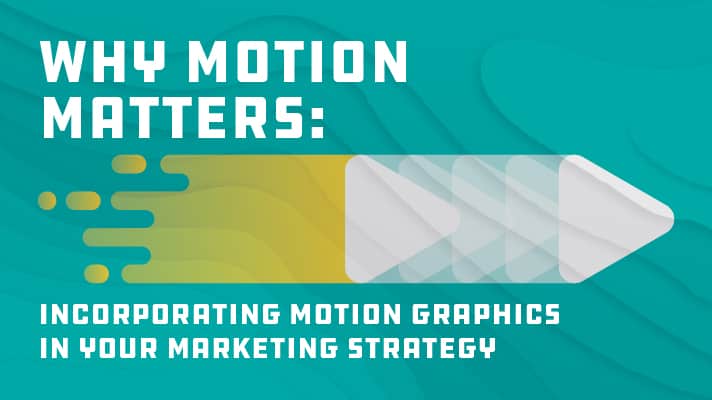People don’t read anymore. Yes, I understand that sounds ridiculous as you are currently reading this. But, it’s true. Today, the average web user only has an eight-second attention span. And of the content they browse online, most don’t even make it halfway down the page before clicking out.
So, how can you elevate your online content to achieve the goals of your marketing strategy?
Lucky for us, written communication is not the only way to get the point across. Plus, one of the most standout ways to elevate written content is by incorporating simple motion graphic effects. It’s just one of the many ways motion matters when creating compelling content.
Did You Know?
Everyone talks about having an elevator pitch. You have between five to ten seconds to snag someone’s interest before they either stop listening to what you are saying or, in our case, bounce out of your website and refresh their social media feeds. Why not allow your content to entertain your audience while providing the information they seek?
A top-notch example of a company that uses stellar motion graphics through its website is Apple. Take a look at their Gen 3 AirPod Webpage:
Yes, it is breathtaking how the full-page motion graphics react to vertical scrolling and mouse movement seamlessly. But, I want to focus on the lower half of the landing page, where there are more achievable elements you could add to your content.
It’s the subtle motion within every few sections of information that keeps you intrigued. Each motion element brings the data to life, from motion showing a pop-up window on the iPhone to the simple fade-in of text. This is the type of animation anyone can easily add to online content to make it more enjoyable for the user.
Why Add Motion Graphics?
Incorporating motion graphics in your marketing strategies is essential with the rapid integration of technology in all areas of life. Utilizing multiple types of content aid a marketing strategy just like the tools on a Swiss Army Knife aid the wielder.
Create Memorable Brand Impressions
Brands benefit from leaving a memorable impression on current and potential customers. And creativity stands out. While using mixed mediums and witty writing can make your brand voice more personable, the user experience remains critical. Adding motion graphics enhances the user experience.
Imagine if Apple didn’t use motion graphics on the Gen 3 AirPod Webpage. Instead, you scrolled through a few paragraphs of text, maybe a bullet point list of product features, and a gallery of photos. Are you bored just thinking about it?
Now Apple doesn’t just throw all the written information out the window. Text is still vital to communicating with your audience. It’s the incorporation of simple motion commands, such as text fade-in, 3D logo effects, and scroll or cursor overlay features.
Easier to Understand Content
Visual content is more stimulating and easier to process, meaning we retain more information. Creative graphics can bring those ideas to life when introducing your brand, telling a story, and sharing your expertise.
Visual communication is more flexible than writing communication. Incorporating video, images, and animation makes the subject more approachable when demonstrating a topic or conveying a complex idea.
Boost Conversion Rates
Social media posts that feature images and videos receive higher interaction rates than posts that only include text. The boost from incorporating visual mediums is also reflected in conversation rates for websites that have motion graphics. According to research by INC., motion graphics increase conversions by an average of 80 percent.
The next generation of consumers is here. Generation Z grew up tech-savvy. And today there is a seemingly unlimited variety of content accessible with the swipe of a finger. Connecting with this diverse pool of consumers means keeping them interested and entertained.
Motion Graphics are Fun
Not only is animation a great way to tell a story and connect to your audience, but it’s also seriously fun. As the user, you are kept on your toes when scrolling to see what happens next. Even simple text animation grabs the attention of users.
For your business, motion graphics have endless possibilities. You can use many techniques and tools to keep things interesting while showing off your brand’s personality. Why tell me when you can show me.
How to Add Motion Graphics?
Adding an edge to your content starts with visualizing your content topic. Depending on the subject, some mediums will be more effective than others. Once you decide what elements to add, you can work on including video, images, gifs, and animation.
There are several tools any marketer can utilize to build motion graphics. At Seventh Scout, we utilize Canva, Elementor, and LottieFiles, in addition to building our own content using Adobe Creative Cloud.
Canva- Canva is an online design and publishing tool. In addition to all kinds of presentations and documents, Use Canva to create infographics, gifs, and social media videos.
Elementor- Elementor is a website builder platform focused on creative design and user experience. Add motion graphics and visual media to any webpage using numerous tools without having to code.
LottieFiles- Lottie is a source of motion graphics. The JSON-style animations can be added to websites, videos, and gifs.
Adobe- For those looking to sharpen their skills in creating their own motion graphics, Adobe Illustrator, Photoshop, and AfterEffects are three programs to get started.
Start small. Incorporating motion graphics into your marketing strategy can begin with learning the right tools. Then, you can look at adding gifs or text animation before building a more interactive user experience on your website.
What to learn about creating engaging online content? Read our blog on ways to maximize your online content.



